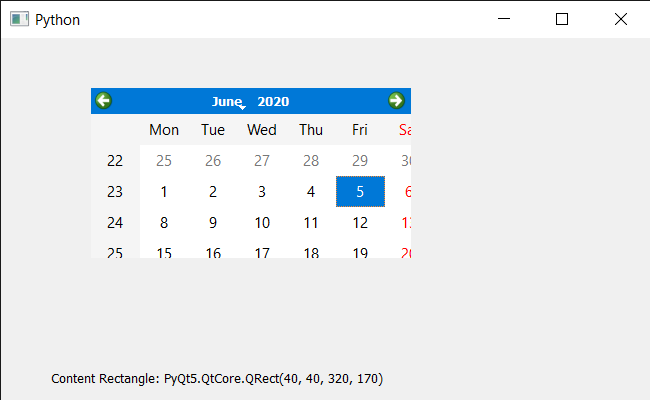En este artículo veremos cómo podemos llevar el rectángulo de contenido al QCalendarWidget. El rectángulo de contenido es el rectángulo delimitador del contenido, por defecto, el valor del margen del contenido es cero, por lo que el rectángulo de contenido es igual al rectángulo delimitador real, pero cuando el margen cambia, se vuelve más pequeño, ya que el rectángulo de contenido es el rectángulo que excluye los márgenes. Podemos agregar margen con la ayuda del método setContentsMargins.
Para hacer esto, usaremos el método contentRect con el objeto QCalendarWidget.
Sintaxis : calendar.contentsRect()
Argumento : No toma ningún argumento
Retorno : Devuelve el objeto QRect
A continuación se muestra la implementación.
Python3
# importing libraries
from PyQt5.QtWidgets import *
from PyQt5 import QtCore, QtGui
from PyQt5.QtGui import *
from PyQt5.QtCore import *
import sys
class Window(QMainWindow):
def __init__(self):
super().__init__()
# setting title
self.setWindowTitle("Python ")
# setting geometry
self.setGeometry(100, 100, 650, 400)
# calling method
self.UiComponents()
# showing all the widgets
self.show()
# method for components
def UiComponents(self):
# creating a QCalendarWidget object
self.calendar = QCalendarWidget(self)
# setting geometry to the calendar
self.calendar.setGeometry(50, 10, 400, 250)
# setting content margin
self.calendar.setContentsMargins(40, 40, 40, 40)
# creating a label
label = QLabel(self)
# setting geometry
label.setGeometry(50, 280, 420, 120)
# making it multi line
label.setWordWrap(True)
# getting content Rectangle
value = self.calendar.contentsRect()
# setting text to the label
label.setText("Content Rectangle: " + str(value))
# create pyqt5 app
App = QApplication(sys.argv)
# create the instance of our Window
window = Window()
# start the app
sys.exit(App.exec())
Producción :

Publicación traducida automáticamente
Artículo escrito por rakshitarora y traducido por Barcelona Geeks. The original can be accessed here. Licence: CCBY-SA